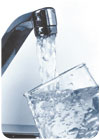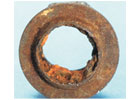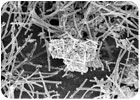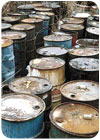
All natural water contains some dissolved gases and minerals.
Overall, ground water is cleaner and purer than surface water. Most ground water moves very slowly, and its long travel time in a dark, cool environment means that it has few, if any, of the millions of microorganisms that virtually always are found in lakes or rivers. Ground water usually is free of sediment and constant in temperature. In addition, ground water naturally is protected underground and less likely to become polluted than surface water. However, ground water may be more mineralized than surface water because its slow movement gives time for it to dissolve minerals from the rocks it touches, allowing it to pick up various rock-related chemical constituents.
These constituents may include trace levels of iron, manganese, calcium, magnesium, sodium, bicarbonate, silica, sulfate, chloride, nitrate and fluoride. Small amounts of these elements and compounds usually do not cause health problems in drinking water. In some cases, however, the levels may be high enough to affect the aesthetics of the water (e.g., staining, hardness) and must be reduced.

The main sources of odor and taste problems usually are harmless. Photo courtesy of The Water Clinic.
Homeowners with wells have primary responsibility for the quality and quantity of their water supply. It is recommended that the drinking water supply be checked with an inexpensive laboratory test each year. Water quality problems can usually be remedied with appropriate water treatment equipment. About 30 percent of the homes in the United States have some kind of water conditioning equipment to meet personal or recommended water quality standards.
Three general categories - physical, biological and chemical - can describe water quality. The effects on water quality in each category are described as follows.

Iron bacteria can complicate water-conditioning efforts. Photo courtesy of The Water Clinic.
Physical Problems
Taste, odor, turbidity and color are the principal physical properties of water that are noticed by end users. Objections usually are made for aesthetic reasons. However, these characteristics may also indicate possible health hazards or the potential for reduced operating efficiency of well equipment, and therefore should not be ignored.Taste and Odor -Taste and odor can affect the quality of water by tainting certain foods and by reducing the palatability of foods cooked in water. The main sources of odor- and taste-bearing substances are harmless organic materials like iron bacteria, and certain inorganic chemical constituents such as hydrogen sulfide.
Hydrogen sulfide is the primary cause for the “rotten egg” taste and odor in water. In high concentrations, it is a flammable, poisonous gas that is highly soluble in water. It also is toxic if inhaled in large amounts. For these reasons, make sure well pits and well houses are properly ventilated. Hydrogen sulfide may be derived from the action of sulfate-reducing bacteria, or by the decomposition of organic matter, sewage and certain industrial wastes. In addition to its unpleasant odor, hydrogen sulfide is corrosive and causes black stains on silverware and fixtures.
Acidic (low pH) water can leach copper out of pipes, causing a metallic taste, especially when the water is not flushed from the pipes frequently. An odor problem may occur with the presence of iron bacteria, which may cause a musty or swampy smell in the water.
Most taste and odor problems are solved by eliminating the substances that are the source of the problem. Treatment techniques include activated carbon filtration and/or oxidation using chlorination, potassium permanganate, ozonation or aeration.
Turbidity & Color-Turbidity is a visual haziness in water that is caused by the presence of insoluble suspended particles. Generally, turbidity is more common in surface water than ground water, because ground water moves too slowly to carry particles of sediment. Turbidity is undesir-able for health, as well as for aesthetic, reasons, because turbidity can interfere with disinfectants and can “piggyback” microorganisms.
Discolored water may contain substances such as organic compounds derived chiefly from the decay of plant and animal matter. Certain metallic ions, such as iron and manganese, sometimes color water yellow, brown or red after contact with air, heat or after disinfection with bleach. Highly discolored water is objectionable because it may stain household fixtures and clothing, as well as reduce the water's visual aesthetic appeal.
Treatments for turbidity and color usually involve settling or filtration.

Bacteria, oxidized iron and manganese, sulfur and other slimy products are slow killers of resin beds and many iron/manganese removal and other filtration devices. Biofilms overwhelm and defeat carbon filters. They also attack or plug reverse osmosis membranes and cartridge filters. Photo courtesy of www.groundwatersystems.com.
Biological Factors
All natural waters, regardless of source, are likely to contain some microorganisms. Microorganisms are too small to be seen without a microscope, and include viruses, bacteria and protozoa. Some types of bacteria cause disease and some impart taste, odor or turbidity to water. Most types of bacteria are not pathogenic (disease-causing).Ground water usually has fewer microorganisms than surface water. Bacteria and viruses (ultra-small microorganisms) either die-out or are removed from water as it infiltrates down through soil and rock, primarily through filtration and adsorption. The number of bacteria may be reduced through competition for nutrients or predation among themselves. In very fine sediments, mechanical filtration may occur as the space between the soil and rock particles acts as a sieve to screen microorganisms out of the infiltrating water.
Adsorption is the adhesion of a substance to the surface of another material because they have opposite electrical charges (like magnets). Soil particles, bacteria and viruses have very slight electrical surface charges based on chemical composition. As the bacteria and viruses pass through the soil zone, they are attracted to negatively charged soil particles and held in-place.
The ability for soil and sediments to filter and adsorb bacteria and viruses depends on the length of contact time between the water and the soil. Longer contact time increases the effectiveness of the soil at removing the microorganisms. Contact times may be increased by reducing the rate of water flow through the soil layer and/or by reducing the concentration of bacteria or viruses within the infiltrating water that the soil must treat. Maximum effectiveness occurs when there is a slow rate of infiltration and thick (deep) soils.
Domestic wastewater, feedlots, surface runoff and other pollution sources sometimes may contaminate ground water. In these situations, ground water is impacted when the soil zone receives more of the nutrient compounds than it can use (short contact times). The excess may be carried down to the ground water or washed into nearby ponds or streams. Ground water from deep, drilled wells does not need disinfection if tests prove that it is free from microorganisms; however, shallow or dug wells usually require periodic or ongoing disinfection.
Pathogenic Organisms -Pathogenic (disease-causing) organisms occurring in water range from ultra-small viruses to microscopic bacteria to relatively large protozoa. Bacteriologic and protozoan pathogens are known to cause typhoid, dysentery, cholera and some types of gastroenteritis. Viruses can cause human maladies including polio, infectious hepatitis and some forms of gastroenteritis.
Biological contaminants are most effectively eliminated by disinfecting water through oxidation (e.g., chlorine disinfection or ozonation), filtration or ultraviolet irradiation. For each method, the equipment must be specifically designed for the intended use and properly maintained. Regular bacterial analysis of the treated water is needed to ensure that adequate treatment occurs. Filtration is more effective in controlling bacteriological impacts when used in conjunction with oxidation or irradiation treatment.
A chemical disinfectant should be effective on many types of pathogens regardless of their quantity, and it should be able to kill all pathogens within a reasonable contact time. The chemical also should be safe and easy to handle, and it should not make the water toxic or unpalatable. In addition, the concentration of disinfectant in the water should be easy to monitor and the disinfection should provide residual protection against any possible recontamination.
Disinfectant-dispersing equipment should be automatic, require minimal maintenance, and treat all water entering the home. It also should be fail-safe so that no one can unknowingly use or consume contaminated water.
Additional information on disinfecting wells for bacteria may be found in the American Ground Water Trust Consumer Awareness Information Pamphlet #10, “Bacteria and Water Wells.”

Industrial chemicals too often are mishandled, ending up in our ground water.
Chemical Concerns
Dissolved substances in ground water may include ions of iron, manganese, calcium, magnesium, sodium, bicarbonate, silica, sulfate, chloride, nitrate and fluoride. Other dissolved mineral substances are possible, depending on local conditions. Those that cause the most common problems in domestic supply water will be discussed here.Two important natural processes - weathering and soil leaching - contribute chemicals to water. Decaying vegetation also adds various constituents and produces mild natural acids that support the soil leaching process.
Man-made causes for dissolved constituents in ground water include all forms of pollution. Disposal of industrial wastes into ground and surface water sources is a contributor to the occurrence of chemicals in water. Chemical fertilizers, petroleum products, pesticides and synthetic detergents also contaminate some water supplies, as do buried wastes.
Because of the health risks of some chemical substances found in water, the U.S. Environmental Protection Agency (EPA) established drinking water regulations that set limits on the concentration of some substances in public drinking water supplies. These limits are helpful in assessing the quality of individual home water supplies.
Hardness and Alkalinity -Hardness, which is very common in water supplies, is caused by calcium and magnesium in water. Hardness at a moderate level (3-7 grains per gallon or 50-120 milligrams per liter) may be beneficial because water becomes acidic at low hardness levels, which may cause plumbing corrosion or leaching of lead from soldered plumbing joints into the drinking water. Hard water is disadvantageous because soap does not clean efficiently and may leave an insoluble curd on bathtubs, sinks, clothing and skin. Hard water also deposits a scale inside pipes, boilers and hot water tanks, reducing their capacity and heat-transfer properties. The condition is commonly treated with water softeners.
Alkalinity is similar to hardness, and is a measurement of your water's overall buffering capacity against extreme pH changes. Its concentration usually is similar to the hardness concentration when calcium carbonate is the main contributing factor to the value. However, if alkalinity is significantly higher than the hardness concentration, the reason may be high sodium in the water. If alkalinity is much lower than the hardness value, the water may be high in chloride, nitrates or sulfates.
Iron -Iron compounds - common in rocks and soil - are easily dissolved in water, particularly acidic water. The earth's crust is a major source of iron; consequently, iron exists in many ground water supplies. Water may also contain iron from corroding metal in pipes, pumps and fixtures.
Small amounts of dissolved iron in drinking water present no concerns, but high levels of iron can cause rusty stains to form on laundry and appliances. Potatoes boiled in iron-rich water turn black, and iron combines with the tannins in tea and coffee to form a black, inky appearance and unpalatable metallic taste. For these reasons, the EPA recommends limiting iron concentrations in drinking water to a 0.3 mg/L limit. This value is an EPA secondary maximum contaminant level (SMCL) guideline (i.e., not legally enforceable by the EPA).
When exposed to air, ferrous iron (dissolved state) oxidizes to form ferric iron (precipitated state), which can form insoluble stain-causing rust. Excess ferric iron creates havoc in plumbing systems, water softeners and other water-related devices.
Iron bacteria create additional problems. Some iron bacteria utilize dissolved iron during respiration. This may cause a rusty color in water supplies, or create a slime that clogs valves, plumbing fixtures and water-using appliances. The removal of iron can be one of the more difficult tasks in water conditioning. Water softeners can remove iron in its soluble ferrous state if no bacteria are present. Some high-end water softener systems can remove ferrous iron at concentrations up to 25 mg/L. Each manufacturer places a limit on the softener's ability to remove iron. Two common iron treatment methods are catalytic oxidizing filters or oxidation-filtration systems. If iron bacteria are present, then chlorination or ozonation also may be required.
Manganese -Iron and manganese often are reported together because they share similar traits and treatment techniques. Manganese has fewer sources in the earth's crust than iron, but it is present in many natural waters. Manganese-bearing minerals are common in rocks and soils, and may also occur in large concentrations in organic material because it is a plant nutrient. In uncontaminated waters, it usually is present at 0.02 mg/L or less; larger amounts of manganese usually are found in acidic waters. Generally, ground water contains more iron than manganese.
Manganese concentrations more than 0.5 mg/L may impart a bitter metallic taste to foods and water, and may precipitate to form noxious deposits on foods during cooking, and black stains on plumbing fixtures and laundry. As little as 0.1 mg/L of either iron or manganese can stimulate the growth of certain bacteria in tanks, filters and water distribution pipes. The EPA recommended maximum concentration [SMCL] of manganese in drinking water is 0.05 mg/L, based on aesthetic concerns.
As with iron, manganese may be removed by a water softener if measures are taken to prevent resin fouling. Each manufacturer places a limit on the softener's ability to remove manganese, and the water chemistry conditions for most effective operation. When the manganese level exceeds 2.0 mg/L, oxidizing filters or oxidation-filtration techniques may be required, but may involve pH adjustment of the water.
Chloride -Although chloride is only a minor constituent in the earth's crust, it is a major dissolved substance in some waters. High chloride concentrations in water are more common in arid and coastal regions than in humid areas. Chloride in ground water may originate in evaporite rock deposits or from seawater trapped in sediments during their deposition. Other sources of chloride include solution of dry atmospheric fallout, municipal sewage and industrial wastes, and road salt.
Chloride in excess of 250 mg/L (i.e., the EPA SMCL) may impart a salty taste (note: seawater has about 19,000 mg/L chloride). In some situations, chloride may accelerate corrosion of pipes, boilers and fixtures.
The best removal techniques for excess chloride are deionization and reverse osmosis. Most equipment designed for chloride removal also reduces sulfate, alkalinity and total dissolved solids.
Nitrates -The common sources of nitrate in ground water are farming and lawn fertilizers or the decomposition of septic waste. The presence of nitrates may be especially harmful to those with potential respiratory impairments, including the elderly or very young children. Nitrates may be transformed into nitrites by bacteria in the digestive tract. Nitrites may then be absorbed into the blood stream. In infant digestive systems, there is insufficient hydrochloric acid to kill nitrite-producing bacteria. Nitrites in the blood stream inhibit the transport of oxygen into the blood stream, which can cause shortness of breath, heart attacks or asphyxiation. Because the condition can create a bluish skin color, it is called “blue baby syndrome” (technically: methemoglobinemia). High nitrate levels commonly are treated with ion exchange or reverse osmosis systems. The EPA enforceable primary maximum contaminant level (MCL) for nitrates in public water supplies is 10 mg/L. Boiling water will increase the nitrate concentration.
Acidic Water and Lead -The acid-alkaline character (or pH) of ground water varies by location. Water may be either acidic (like vinegar) or alkaline (like ammonia); pH values range from 0 to 14. Ground water pH values commonly range between 6.5 and 8.5. A pH of 7 is neutral. Values higher than 7 are considered alkaline or basic. Values less than 7 are indicative of acidic water. Acidic water often is corrosive, especially if combined with low hardness and low alkalinity. Corrosive water may leach metals (copper, lead, etc.) from water pipes into drinking water, creating a metallic taste. Alkaline water with pH values greater than 8.5 tends to have a bitter or salty taste. The alkalinity level (which is a separate measurement) indicates your water's buffering capacity against extreme pH changes.
Most water treatment systems work more effectively when the pH is near neutral. For this reason, it may be necessary to neutralize the water (correct the pH) before treating it for other problems.
Industrial Chemicals -This is a general term for a broad range of hazardous or regulated substances and waste products that are not naturally occurring. They may end up in the ground water supply if they are improperly handled. A few examples of these types of materials include organic compounds (e.g., benzene, MTBE), heavy metals (e.g., cadmium, chromium, lead, mercury, etc.), pesticides and herbicides, polychlorinated biphenyls (PCBs), petroleum hydrocarbon fuels, and polycyclic aromatic hydrocarbons (PAHs).
The treatment of these and similar types of chemical pollution should be considered on a case-by-case, site-specific basis so that the most appropriate solution is implemented. It is important to determine the source of these contaminants before a solution is chosen. Treatment methods may include activated carbon filtration, aeration, ion exchange, neutralization and others, including combinations of these methods.
Fluoride -In some areas, high fluoride concentrations in ground water occur naturally. Currently, there is scientific debate regarding the health benefits derived from fluoride in water and the optimum concentration to create the benefits. The EPA SMCL is 4 ppm, but the homeowner should consult a physician and/or dentist to determine what level of fluoride in water would be best. The level is likely to be lower than 4 ppm.
Water treatment to remove fluoride generally is accomplished through specialized and expensive ion-exchange processes. Reverse osmosis also is an alternative treatment.
Radon -Radon is a colorless, odorless and tasteless radioactive gas. It is formed during the decay of naturally occurring minerals containing radioactive elements such as uranium. Radon gas may enter a home through two primary pathways that include 1) cracks in the foundation and 2) release from the water supply used inside the home.
There is uncertainty among scientists about the health risks related to dissolved radon in drinking water. Currently, the EPA advisory action level (guideline) for radon gas in air is 4 picoCuries per liter (pCi/L). In 1991, the EPA proposed a MCL of 300 pCi/L for dissolved radon in public water supplies, but this value is under reconsideration by the EPA. A water user can contact local or state health or environmental quality authorities for updates on the permissible levels of radon in air or water.
Radon in water commonly is treated through aeration. Activated carbon filter treatment is not recommended because of the potential build up of radioactivity in the filter as the radon is removed from the water.
ND
Report Abusive Comment